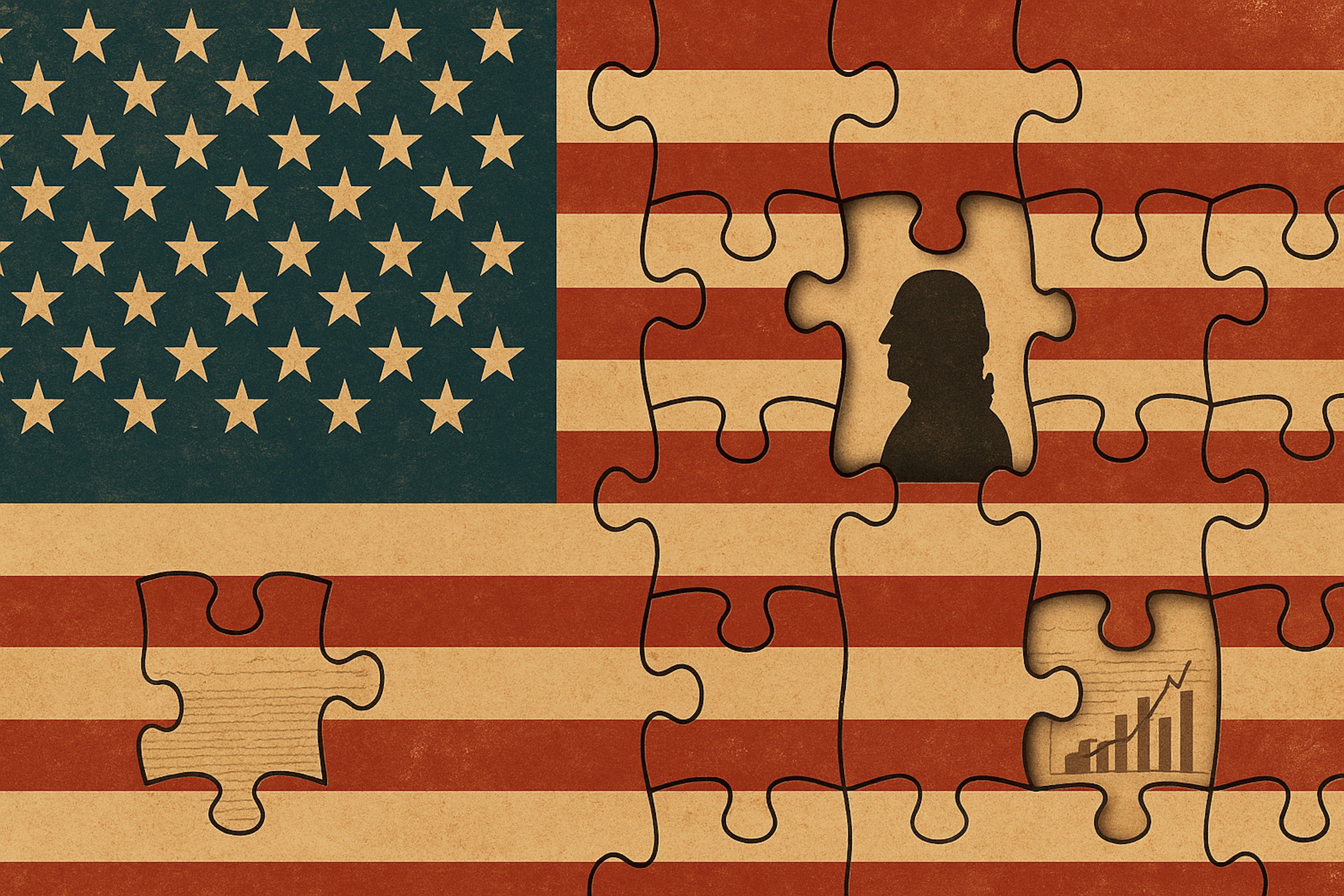From political slugfests to classroom battles, historian Marc Egnal talks with INET’s Lynn Parramore about the need for a new approach to our national story.
In his new book Challenging the Myths of U.S. History, historian Marc Egnal takes aim at the stories Americans like to tell themselves — on both the right and the left.
He argues that America’s path has been shaped less by abstract ideals and more by the economic and territorial ambitions of the upper class. Racism, he says, wasn’t an unfortunate byproduct, but deeply woven into that drive for expansion. Egnal takes aim at both ends of the political spectrum: he challenges MAGA efforts to whitewash the uglier parts of history, but also critiques the “liberal synthesis” — the familiar story that admits past wrongs but still frames the U.S. as steadily marching toward freedom and progress.
Egnal’s take on U.S. history lays bare the roots of today’s chaos — political dysfunction, rising violence, Trump’s staying power, and the economic pressures Democrats keep missing. In a conversation with the Institute for New Economic Thinking’s Lynn Parramore, he breaks down how the past still drives the battles shaping America now.
Lynn Parramore: You argue that America’s development was driven less by abstract ideals like liberty and more by the economic interests of its elite — especially their pursuit of growth and expansion. How does this challenge the narrative of American exceptionalism?
Marc Egnal: American exceptionalism meshes nicely with the “liberal synthesis,” the story that people learn in school. The United States, like many countries, has its own myths. The U.S. myths go back to the “City on a Hill” and John Winthrop — the whole idea that it stands alone, apart from other nations. The country’s history, as it’s taught and understood, really circulates around these myths.
Textbooks reinforce this outlook and point to a few high-minded documents as the key to America’s past. The Declaration of Independence is ennobled, the Gettysburg Address is celebrated. Those dots are connected to shape the narrative of the United States as a country guided by high ideals, more so than other nations are. It’s the country of the Statue of Liberty.
While that’s not an absolute fabrication, it is a myth. It’s not the substance of what actually went on.
LP: You stress that historians should ground their work in evidence, not political agendas. How does that principle apply to today’s debates over how schools teach history, especially on race, inequality, and national identity?
ME: Starting in the 1960s and continuing into the 1990s, the liberal synthesis emerged. That’s the idea that America has faced problems in areas like race, foreign policy, inequality, and the position of women, but bit by bit, progress prevailed. We’ve addressed these issues through two waves of feminism, the Civil Rights Movement, and so on.
LP: The arc of the American story bends toward justice.
ME: Exactly. I offer a critique of that retelling from one perspective, while MAGA and Trump approach it from a very different one. What angers MAGA is the uncomfortable fact that America had aspects as nasty as racism and slavery, and that many Southerners (and others) actively defended it.
The demand that we accept, or even honor, Confederate leaders and name military bases after them is their response to that history. They brush aside rebellion and racism. But if you look at professional historians — the members of the Organization of American Historians or the American Historical Association — almost uniformly, they reject the MAGA/Trump perspective as a distortion of the past.
At the same time, I argue that the liberal synthesis has its shortcomings too.
LP: Let’s talk about those limits. Take the Civil War — how does the liberal synthesis explain its causes and what each side was fighting for? Where does it fall short?
ME: The liberal synthesis sums up the cause of the Civil War in a single word: slavery. It’s primarily framed as a moral conflict. The North opposed slavery on ethical grounds, while the South defended it. The war is seen as the result of a fundamental moral disagreement between the two sides.
Overwhelmingly, professional historians adhere to that view. They reject the state’s rights explanation. I don’t accept the state’s rights view either, but the idea that the North went to war because of a moral revulsion against slavery doesn’t stand up to the facts. The abolitionists were a small, reviled group in the North. And when the North went to war in April 1861, Lincoln was willing to accept a 13th Amendment — not the one we know that ended slavery, but one that would have constitutionally protected slavery where it already existed.
LP: And support for slavery wasn’t confined to the South — many New Yorkers are surprised to learn that the city’s mayor once advocated secession, given the city’s deep financial ties to the South, especially through the cotton trade.
ME: Yes. A good example of the play of economic interests.
LP: You point out that a key goal of the North in the Civil War was to build a strong, federally-backed industrial state. Is that mission is still shaping our politics and economy today?
ME: Absolutely. Understanding the Civil War as driven more by economic goals than by a commitment to ending slavery helps us see how those priorities still shape American politics and the economy today.
While emancipation became a wartime strategy — through the preliminary and final Emancipation Proclamations — the North was never deeply committed to Black rights. Even though 90% of free Black people lived in the North, most northern states denied them the right to vote, except in parts of New England. That lack of commitment made it easy for the North to abandon Reconstruction.
Racism was intertwined with the North’s goals of economic and territorial expansion. From the founding of the country, the Constitution was a compromise with slave states. And during and after the Civil War, the North prioritized building a strong industrial nation over securing rights for Black Americans.
After the war, the northern-led Congress shifted focus: federal troops were withdrawn from the South and redeployed westward against Native Americans, and later into cities to suppress labor movements. The income tax used to fund the war, one of the few progressive measures, was repealed, but massive federal spending continued for railroads and infrastructure. Freed people received almost no land, while railroads were granted millions of acres.
There are striking quotes from African Americans at the time, noting that there was nothing for them, but everything for the Union Pacific Railroad. That legacy still echoes in the structure of our politics and economy today.
LP: See any parallels between the historical use of federal troops to serve elite economic interests and what we’re witnessing today?
ME: Well, the movement of troops into Los Angeles or Portland or Chicago is not there for economic growth. It’s there because of an animus towards certain people. There are continuities and contradictions. During Reconstruction federal troops protected the freedpeople. Under Trump, the federal presence is directed against immigrants who do not have full citizenship, even if they have been in the country for decades, and are law-abiding, tax-payers with American-born children.
LP: Might that animus toward certain people ultimately serve the interests of the wealthy today?
ME: Good question. I actually see Trump as a departure from the economic strategies of both Democrats and Republicans before him. For decades, you could argue that much of what was happening, despite the problems, still tied back to promoting economic growth. But with Trump, that connection breaks down.
Take race, for example. I don’t think Trump’s policies on race or immigration actually further growth.
His tariffs, for instance, haven’t helped the economy. His aggressive stance on immigration has likely hurt it. Same with the direction of his tax policies. So unlike earlier periods, where elite interests and economic expansion were clearly linked, under Trump that link becomes much harder to see.
LP: So you think that the story of American growth and expansion is taking a turn?
ME: It has definitely taken a turn. I’m usually one of the first to look for economic motives behind foreign and domestic policy, and you can find them throughout much of U.S. history. If we’re talking about FDR, TR, or many other presidents, their actions often aligned with promoting economic growth and national power.
But with Trump, so much of what he does runs counter to that. His policies frequently contradict the very goals that would strengthen America economically.
LP: What about policies that may hurt the broader economy but may benefit a small, well-connected group? Some might point to crypto as an example.
ME: It certainly very much benefits the Trump family, and it’s part of this growing divergence between what’s good for the country economically and what benefits a small, wealthy segment of society.
Take a traditional company like General Motors. I’m in Canada, and as we Canadians know, auto parts and vehicles cross the border repeatedly — sometimes a dozen times back and forth during production. Trump’s policies hurt producers on both sides of the border. When tariffs raise the cost of aluminum and steel, they disrupt that flow and again hurt manufacturers.
CNN recently ran a series interviewing small business owners, and almost all of them said the tariffs are damaging. They can’t source materials affordably, and it’s hurting their bottom line.
Trump is a classic populist. He’s gained strong support from much of the working class and less wealthy Americans, by racial and ethnic appeals, but his actual policies hurt them and favor a narrow slice of the elite — another hallmark of populism.
Look at the Trump family — Kushner, for example. He’s not just over there working on Middle East brokering diplomatic deals; he’s also looking out for people like the Witkoffs and the Kushners themselves. It’s classic modern populism: broad working-class support, but real benefits flowing to a small group at the top.
LP: Is that really a break from U.S. history? Haven’t we seen cronyism before?
ME: We have seen cronyism before, no question. In the 19th century, for example, tariffs helped industrialists like Carnegie and supported the growth of key sectors like steel and railroads. So yes, there were favors and insider advantages.
But I think what’s different with Trump is the narrowness of the circle that benefits. It’s not about building a national industrial base — it’s about rewarding a small group of personal allies. You see it in who shows up at his inauguration, who gets access, who benefits. It feels less like national economic strategy and more like a private network of loyalists.
LP: Let’s talk more about who America’s story leaves behind, and what happens when they try to push forward. You discuss the Sheppard-Towner Act of 1921 — a kind of precursor to Social Security for women and children —that was labeled “socialist” and repealed by 1929. What does this reveal about the limits of social programs in U.S. politics, especially for women and families?
ME: The demise of that welfare measure reflects deep resistance to federal intervention, especially after the first Red Scare. Sheppard-Towner, which supported maternal health, was remarkably progressive for its time, but it triggered fears of “big government” — similar to the backlash we see today, backlash that is playing out in the government shutdown.
Social programs at every stage face pushback. We saw it with Truman’s push for universal healthcare, with the ACA, and even now, in debates over Medicaid expansion. And that resistance often has a racial and gendered dimension.
The divisions are deep and interconnected, cutting across race, gender, and region. Look at the 19th Amendment granting women the right to vote: Western states ratified it early, Southern states resisted. Today, many of the same states still haven’t expanded Medicaid, despite overwhelming federal support.
LP: You argue that white Christian identity is central to MAGA. Why do you see that as the core, rather than economic issues like job loss or globalization, which others emphasize?
ME: In 2016, Trump stood out, not for his economic policies, but for appealing to voters with strong anti-Black and anti-immigrant views. His base was energized by that rhetoric, unlike the tepid support for Cruz or Rubio.
Economic issues mattered, but they didn’t unify the MAGA base. Many who liked Obama’s economic policies weren’t drawn to Trump for that reason.
His message focused on building a wall, banning immigrants, and using inflammatory language. In 2024, economic issues were the frosting on the cake, and in the wake of the Biden inflation, it was a very tasty, attractive frosting. He strengthened and enlarged his support by offering simple solutions — cutting taxes, raising tariffs, and expelling immigrants. These policies don’t really work, but they spoke to people in economic pain. Their failure is now leading to a falling off in the support from independents.
Democrats, by contrast, have failed to address economic pain.
LP: Trump’s support among Black voters nearly doubled from 2016 to 2024. One survey showed 1 in 4 Black men under 50 backing him, and 9% of Obama voters switching to Trump. How do you explain that?
ME: It’s complex, but a key reason is that Democrats abandoned working-class voters, including Black and Hispanic men. In a telling interview I listened to during the 2024 campaign I heard a Las Vegas hotel worker say, “What do Democrats offer me? I can’t afford groceries or a home, and I don’t hear solutions.”
Even if Trump’s policies are BS, he spoke to their economic distress, something Democrats failed to do. For the first time, a majority of Hispanic men voted Republican, and more Black men shifted too, appealing to economic concerns.
LP: Why haven’t Democratic leaders connected with these economic issues?
ME: Since 1972, Democrats moved away from unions and working-class focus. That year’s convention set quotas for race and gender but ignored labor. Carter and Clinton pushed the party toward elites. Now, it’s a party of the wealthier third, mostly college-educated folks who often can’t relate to the working class. Bernie Sanders summed it up: “No wonder the working class abandoned us — we abandoned them.”
LP: There’s strong public support for Sanders-style economic basics, also reflected in backing for NYC mayoral candidate Mamdani’s affordability message. There’s also interest in Ezra Klein’s “abundance agenda,” focusing on growing the economy and expanding middle-class opportunities rather than just affordability. How do you see these two approaches from Democrats?
ME: I enjoy listening to Ezra Klein, but his abundance agenda mainly speaks to middle and upper-middle-class Democrats, counseling them to move away from NIMBYism and facilitate the construction of infrastructure and housing. To be sure, those are worthwhile goals. But they don’t address the deep inequalities that burden society. The real issues are growing inequality, persistent racism in education and healthcare, and tax breaks for the wealthy. More infrastructure projects won’t solve those.
LP: Are the affordability and abundance ideas mutually exclusive?
ME: No, but affordability tackles more fundamental problems. To win back working-class voters, Democrats need to focus there. Middle and upper-class progressives like Ezra Klein won’t disturb the wealthy, but progressives like Mamdani, who push for taxing billionaires, do. It’s disgraceful that Chuck Schumer and Hakeem Jeffries keep their distance from Mamdani, despite his broad appeal and ability to enlarge the Democratic electorate. I applaud those congressional leaders’ emphasis on Medicare and Medicate in this shutdown. It’s an important, but still a timid first step.
LP: What would going further look like?
ME: It would mean uniting behind housing, medical care, and other affordability issues that are important to 90% of the American population. It would mean not being content to run on a platform that simply says, “We are not Trump.” Note that the U.S. spends more per capita on health than any wealthy nation but has worse outcomes.
LP: What do you make of Trump’s current focus on drug prices, like the “most favored nation” rule and TrumpX website? His talk on this resonates with many people.
ME: It’s mostly bluster. He said similar things in 2016 and never followed through. Occasional populist talk from politicians disappears quickly.
LP: Do you think minimizing the role of economic power and wealth has blinded us to how politics really works?
ME: Absolutely. It causes many historian to embrace an optimistic, teleological view of progress that ignores ongoing inequalities. I want to be optimistic, but it overlooks present realities.
LP: There’s obviously an emotional component to myths— people want to take pride in their country and feel defensive when faced with harsh realities. How do you respond to that?
ME: There’s certainly a proud tradition of resistance in the U.S.: abolitionists, civil rights, the women’s movement, LGBTQ+ rights, labor — all have made real gains, though those gains face ongoing challenges.
Oppressive structures and resistance coexist. We remain a racist society, and a society where sexism is pervasive. Just look at the sewer of content that shows up on X, 4chan, and other social media platforms.
Still, no one should get so discouraged that they stop struggling. One way of looking at American history — and this would be a different book, but a plausible one — is to focus on how long and hard people have fought to make things better. In my book, you can see how powerful the forces are that have supported an oppressive status quo. But I’m optimistic in the sense that we have had these protest movements. People have done incredible things. Coalitions have pushed society and the economy toward more inclusivity. That gives me hope.
But yes, I’m realistic about how hard it is to hold on to those victories — how fierce and entrenched the opposition is.
LP: Yes. And we can never, ever take those victories for granted.
ME: We never can.





